Extract from The Guardian
If leaders in Glasgow do not act to ratchet up carbon cutting, the alternative is a dialling up of calamitous global heating
Last modified on Fri 29 Oct 2021 06.05 AEDT
Cop26 may involve dozens of world leaders, cost billions of pounds, generate reams of technical jargon and be billed as the last chance to prevent calamitous global heating, but at its simplest the climate conference in Glasgow is a debate about dialling up or dialling down risk.
Dialling up
1.1C
The world has already heated up by about 1.1C since the Industrial Revolution. Even at this level, delegates no longer need to read scientific studies to understand how 200 years of emissions, exhaust fumes and tree burning have destabilised the climate. All they have to do is look out the window or read recent local and global headlines. The host city, Glasgow, has just sweltered through its hottest summer on record. Globally, in the summer of 2021 there were record temperatures, fires and floods across the world, killing hundreds in the north-western Americas, choking swathes of Siberia, inundating cities in Germany and drowning subway commuters in China.
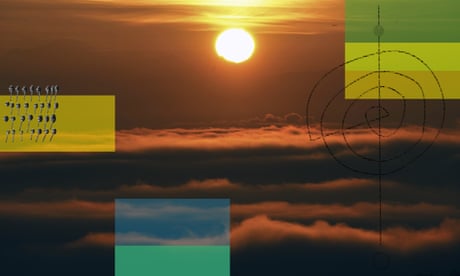
The heat has carried on into the autumn. At least four nations have experienced their warmest October days on record: Iran (46C), Morocco (43.5C), China (38.9C) and South Korea (32.3C). This is not a one-off. As with a human body, the difference between a healthy temperature and a planetary fever can be less than 1C. The past 10 years was the Earth’s hottest decade since measurements began. Even at the current level, the UN secretary general, António Guterres, has declared a “code red for humanity”. But it is too late to stop at this level because additional warming is already baked into the system.
1.5C to 2C
The primary objective of Cop26 is to nudge the world as low as possible within this target band, which was established under the Paris agreement. 1.5C is considered the safest climate landing zone that humanity might still reach. A slip of even half a degree would dial the risks up substantially, according to the world’s top climate scientists on the UN Intergovernmental Panel on Climate Change. Their computer models suggest 420 million more people would be frequently exposed to extreme heatwaves and heat-related deaths would rise twice as fast if temperatures reach 2C rather than 1.5C.
That half a degree would mean significantly more climate-related water stress, hunger and poverty, particularly in the poorer parts of the world. In the Sahel, Amazonia, southern Africa, central Europe and the Mediterranean, the risk to food security would be rated as “high” rather than “medium”. In South Africa and the Mediterranean, the likelihood of extreme drought would be substantial, while economic growth would take more of a hit, especially in Africa, India, south-east Asia, Brazil and Mexico.

The Earth’s other inhabitants would suffer far more with half a degree less breathing space. At 2C, 18% of insect species, 16% of plants and 8% of vertebrates are projected to lose half of their habitats, at least double the proportions at 1.5C. This would put more stress on food production, pollination, water quality and other biological components of the planetary life-support system.
The Amazon and other tropical rainforests would also stand less chance of surviving. The hotter, drier and more fragmented these ecosystems become, the higher the risk they degrade into dry savannahs. At 2C, warm spells are projected to be a month longer than at 1.5C, dry spells twice as long, and extreme temperatures three times more likely.
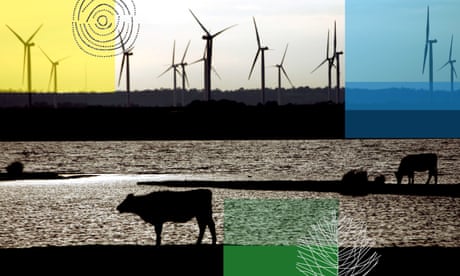
For the world’s oceans, 2C rather than 1.5C would mean increased ocean acidification, oxygen depletion and more dead zones. This would raise the pressure on fisheries and give corals a vanishingly small chance of survival.
Turning up the heat by that half degree would make ice-free Arctic summers 10 times more likely and expose up to 2.5m sq km of permafrost to melting. By the end of this century, sea levels are likely to rise at least 10cm more than they would at 1.5C, leaving 10.4 million more people vulnerable to inundation. That half a degree would raise the possibility of bigger systemic risks, perhaps through a single massive event, such as the breakup of a major Antarctic glacier, or in the form of a cascade of multiple tipping points. But rather than a cliff that humanity topples over, 2C is more likely to be just another notch on the dial. On current trends, it won’t be the last.
2C to 3C
The world is on course to become 2.7C hotter, the UN calculated last month. Patricia Espinosa, the UN’s chief climate negotiator, said this was “a huge cause for concern”. If countries lose faith in the Paris process and pull out or backtrack, as the US briefly did under Donald Trump and Brazil is now doing under Jair Bolsonaro, temperatures could easily creep beyond 3C.
At this level of heating, the projected length of the average drought rises to 10 months, up from 2 months at 1.5C, while the area burned by wildfires doubles. In Britain the number of hot days would probably double and maximum temperatures would be close to 40C. Add another half a degree of global heating and ice-free summers in the Arctic are almost certain every year, while the risk of marine heatwaves – which can devastate populations of fish and crustaceans – is likely to be 41 times higher than it was in the pre-industrial age.

A person walks along a road in a region of Madagascar that is prone to drought. Photograph: Rijasolo/AFP/Getty Images
Dialling down
Those risks can be dialled down if governments ratchet up carbon-cutting ambitions at Glasgow. “This is one of the most important Cops we have had in a long time,” said Jennifer Morgan, the executive director of Greenpeace. “On a fundamental level, what is at stake is whether the leadership of the world is going to treat the climate as the emergency that it is and take a series of decisions to keep 1.5C in sight.”
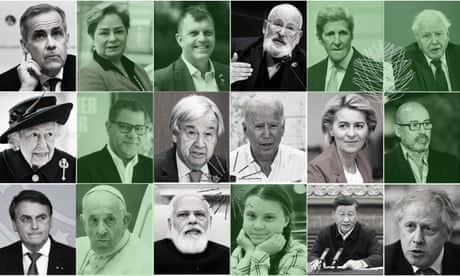
There has been progress. Over the past two years, net zero announcements by the UK, EU, US, Japan, South Korea and China have raised hopes. More than 100 countries have upgraded their plans, and others continue to trickle in. This month, Turkey finally ratified the Paris agreement and promised to peak CO2 by 2035. Shortly before that, South Africa pledged to lower its 2030 emissions cap by a third.
Carbon Tracker calculates all commitments and announcements up to November 2020 could constrain global warming to 2.1C if every country keeps its pledges. With six of the 10 biggest emitting countries yet to disclose new plans, there is a chance this could get closer still to 1.5C in the coming weeks.
The world’s richest countries must take the lead. According to the World Resources Institute, action by the G20 alone could limit warming to 1.7C.
For Bob Ward of the Grantham Research Institute on Climate Change, the wishlist includes China’s emissions peaking five years early in 2025 and India setting a net zero target for mid-century, with the US, EU and UK setting strong near-term targets for carbon reductions and making up the $20bn a year shortfall in climate finance support for poor nations. “The worst outcome would be for rich countries to be perceived as being an untrustworthy partners for developing countries, undermining all other parts of the negotiations and leading to serious doubts about whether the Paris agreement will ever be implemented,” he said.
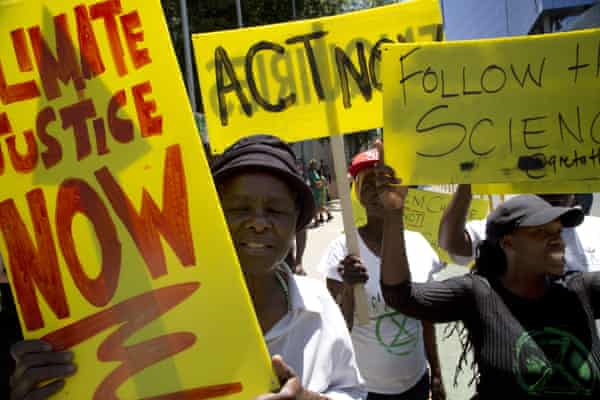
Demonstrators hold up placards during a climate protest in Johannesburg in 2019. Photograph: Denis Farrell/AP
Along with international solidarity, Glasgow will be a test of credibility. “What we are looking for in Glasgow is not more statements and commitments, but credible plans that we can scrutinise,” said Chris Rapley, a professor of climate science at University College London.
Rapley said the UK and many other governments have been getting by on vague promises since Paris. Others such as Brazil and Australia have backtracked or tried to fudge their carbon accounts. “Six years have drifted by. We have been burning up the carbon budget despite the Covid lockdown. Now there is even less time. Cop26 needs to be where we go from promises to hardcore plans that will take us as close to 1.5C as possible.”
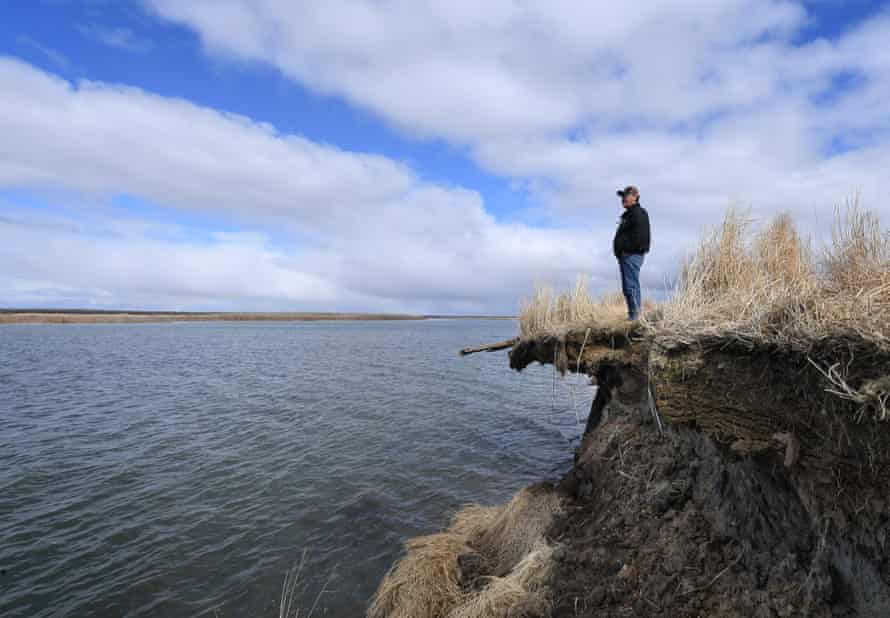
Erosion caused by melting permafrost tundra and the disappearance of sea ice on the Yukon delta in Alaska. Photograph: Mark Ralston/AFP/Getty Images
The best outcome would be a grand bargain – a Glasgow pact – that brings 1.5C into sight. The worst would be a breakdown of unity that raises the prospect of temperatures scorching past 3C. More likely is something in between.
Lauri Myllyvirta of the Centre for Research on Energy and Clean Air says a “realistic successful outcome” would be concrete, trackable steps between now and 2025 to achieve net zero goals, new commitments from countries such as India, Russia, Saudi Arabia and Indonesia that have yet to update their nationally determined contributions, and a clear message from China, the US, the EU and Japan that the financial tap for coal projects has been switched off for good, while the channel of cash for renewables will be opened wider.
Public pressure will be crucial. Greenpeace’s Morgan said she was more hopeful than she had been at the start of the year. “People are engaging in all of this. Movements are coming together and getting invigorated and you start to see a response by politicians on that. There is a lot of positive energy … I think what we will get is a very strong demonstration of public support around the world for a more systemic transformation and leaders will feel bullied and brave because of that. But I don’t know if they will lean in and have the courage required by this moment. It is an incredible moment.”

No comments:
Post a Comment